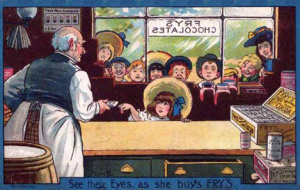Technological Revolution
There is no record of when or by whom the first cacao beans were made into chocolate, The meso-Americans at some point in time must have discovered an inventive way to drink and process cacao for consumption. They developed a method on how cacao beans would be processed from the cacao pods and grinded with stone tools to form a liquid which is drinkable and contained loads of healthy nutrients for the human body in physical and medicinal ways. This chocolate became a luxury beverage and currency in Mesoamerica was a desired product by the European colonists. For centuries after the conquests of the Americas the European spent money and research into applying cacao to meet European hierarchical tastes. Eventually a breakthrough was made, and chocolate became a popular product to eat and drink in Europe. In modern day Europe, chocolate is a widely consumed product which is loved by the youth, adults and royalty alike. So, how did chocolate transform and start European industrialization? To look into how this occurred, we will examine Spanish and Portuguese manufacturing of chocolate, using machines to make chocolate, and how milk transformed chocolate. Chocolate became a product which took centuries of trials and errors to perfect it to modern standards.
The Spanish and Portuguese empire were the first to manufacture chocolate as they held control over the lands where cacao was suited to grow in. The Spanish were the first to modify and change the Aztec procedure. They edited the process by including the Aztec procedure with European technologies. An example of a modification they made was using bean roasting cylinders which mixed the beans while roasting. This process was also revolutionized later on by adding water. “The Spanish process was described as barely drying the cocoa (powder), producing a less bitter, greasy chocolate, whereas cacao (beans) imported to Italy were roasted at a higher temperature that resulted in a more bitter aromatic chocolate” ( Snyder 612).
This chocolate was still only used for beverages, their counterparts in Europe also practiced using high temperatures when roasting the chocolate only for the product to be burnt and taste like charcoal. The process was improved when many original processes done by hand were now done by machine.
This was the start of the chocolate revolution and industrialization in Europe. The process of making chocolate was revolutionized by the Swiss when they introduced a mechanized factory in lake geneva. The inventor Francois-Louis Cailler had a vision on a new productive way to manufacture chocolate by reducing costs and improving the quality. The European process began with melangeur, which is two iron roll refiners which grind sugar and liquor into dough. The European manufacturers believed that by mixing sugar and liquor this was the only way to make good tasting chocolate. To research and experiment into other known chocolate recipes such as the 1600s Jamaican recipe involving the use of milk in their procedure, this led to European manufacturers to experiment.
It is not a coincidence that milk chocolate when first produced 1876 by inventor Daniel Peter also came out of switzerland. Switzerland is known for milk being an abundant product. The adding of milk into the chocolate procedure allowed for chocolate manufacturers to produce more edible products as the milk added volume and cut costs on the amount of imported cacao beans. This meant that these factories could produce more chocolate at a lower cost with increased profits as this variety of chocolate became immensely popular. There was trouble in making this process as milk has a high-water content which at first resulted in an unpleasant smell in the product. By 1867, the Anglo-Swiss condensed milk company found a way to condense the milk. This resulted in a smooth chocolate recipe which had cacao butter, sugar, cacao powder, and condensed milk. Peter experimented with this recipe by regulating the temperature. As a result, Daniel Peter’s Chocolat au lait was born. This became an instant success with the public and the new process was adopted by the chocolate industries across the world. The word “chocolate” would also become defined with eventual processing which resulted in melting the chocolate in a process called conching.
In conclusion, chocolate transformed Europe by bringing it into the early stages of the industrial revolution. The use of new ideas and concepts along the subject of chocolate pioneered breakthroughs in other fields. The use of machines eventually led to the assembly line and other factories were also replacing hand only labor with sophisticated machine processes. To look into how this occurred, we examined Spanish and Portuguese manufacturing of chocolate, using machines to make chocolate, and how milk transformed chocolate. Chocolate was an early indicator which signaled a new wave of thinking and enlightenment. Chocolate has come a long way from an unknown origin.
Bibliography:


Comments
Post a Comment